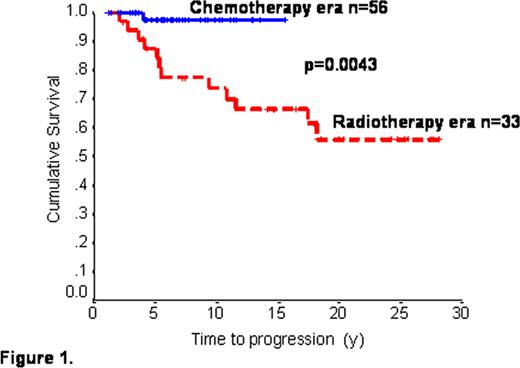Abstract
Abstract 3887
The appropriate therapy for limited stage NLPHL is the subject of debate. With favorable outcomes frequently reported, attempts have been made to reduce acute toxicity. In contrast to classical Hodgkin lymphoma, chemotherapy (CT) is often omitted; however, whether this omission affects outcome is unknown. At the BC Cancer Agency (BCCA), treatment guidelines are centrally driven and practiced throughout the province, facilitating survival comparisons across different treatment eras. Herein, we evaluated the outcome of patients with limited stage NLPHL treated with incorporation of ABVD (CT era) compared to those treated in the radiotherapy (RT) era.
The BCCA Lymphoid Cancer Database was used to identify all patients with limited stage NLPHL (non-bulky (<10cm) stage IA, 1B, 2A). Initially 106 patients were identified, however, following pathology and chart review 17 were excluded due to: an alternate lymphoma diagnosis (n=3); (non Hodgkin lymphoma not otherwise specified n=1; diffuse large B-cell lymphoma n=1; composite lymphoma n=1); diffuse morphology and blocks were not available for immunohistochemistry (n=2); benign histology (n=2); concurrent epithelial cancer (n=1); diagnosis out of province (n=9). Of the remaining 89 patients, 78 (88%) had a confirmed diagnosis of NLPHL and in 11 cases (12%), the slides or paraffin blocks were unavailable for re-review. In general, patients were treated according to era-specific guidelines: Before 1993 (n=33) extended field radiotherapy (RT); 1993-present (n=56) ABVD-like CT for 2 cycles with extended field RT (1993-1995), involved field RT (1995-2001) or involved nodal RT (2001-present) with the exception of 11 patients who received ABVD alone.
The majority of patients were male (67%), with a median age of 36.5 y (15-77) and 55 had stage I disease (62%). With a median follow-up of 6.4 y for living patients (range 1.2–40.5 y), the 10 y time to progression (TTP), progression-free survival (PFS) and overall survival (OS) for all 89 patients were 86%, 78% and 88%, respectively. Most patients were treated using the above guidelines except for 2 patients who were treated with MOPP CT + RT (physician's discretion) in the RT era and 6 patients treated solely with RT in the CT era (initial therapy out of province (n=1); high neck presentation (n=3); CT refusal (n=1); cardiac disease (n=1). In addition, 2 patients had undergone surgical resection alone in the RT era because the diagnosis of NLPHL was made retrospectively. In an era to era comparison, the 10 y TTP (98% v 74% p=0.0043, see figure 1), PFS (91% v 63%, p=0.0015) and OS (93% v 82%, p=0.053) favored the CT treatment era (> 1993) compared to the RT treatment era. Interestingly, there have been 5 cases of transformation to aggressive lymphoma in patients treated in the RT era and none in the CT era.
In an ‘as treated’ analysis, patients given CT (n=52) had a superior 10 y TTP (97% v 77.5, p=0.0108) and PFS (90% v 66.5%, p=0.0035) versus those treated exclusively with RT (n=35). The sole patient who relapsed after CT had received MOPP. No patients treated with ABVD (n=50) have relapsed or developed transformed lymphoma. In multivariate analysis including treatment era, age >40 y, stage II disease, mass size > 5 cm and male sex, treatment in the CT era was the only factor impacting TTP (p=0.022, HR .088 (CI .011, .702)) and PFS (p=0.001, HR .126 (CI .028, .464)) and there was a trend towards an improved OS (p=.089 HR .156 (CI .018, 1.324).
Since the introduction of ABVD CT into the treatment of patients with limited stage NLPHL, outcomes have improved considerably and patients are more likely to be cured of their lymphoma.
No relevant conflicts of interest to declare.
Author notes
Asterisk with author names denotes non-ASH members.


This feature is available to Subscribers Only
Sign In or Create an Account Close Modal